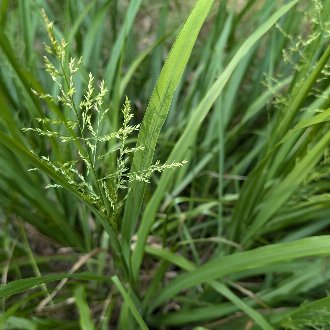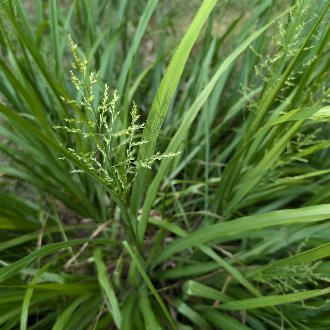Beaked Panicgrass (Coleataenia anceps (Michx.) Soreng)
Also known as Panicum anceps Michx..
↑Summary
A perennial, warm-season grass native to the southeast.
↑Habitat
Coleataenia anceps is found throughout the southeastern to south-central US in a wide variety of open, disturbed habitats. It prefers but is not restricted to moist sites, and it grows best with about 65-70% direct sunlight and 30-35% shade. Natural habitats include swamps, both alluvial swamps and upland depression swamps, seasonally-exposed sandbars, drier margins of marshes, dune swales, pine savannas and pine flatwoods, large gaps in hardwood and pine-hardwood forests, and recently-burned sites. It is common in disturbed anthropogenic habitats including abandoned agricultural fields, recently-thinned forest plantations, roadside ditches, and weedy margins of suburban gardens, and can even grow in lawns, particularly if they are infrequently mowed in summer.
It most frequently grows in or near wetlands, but can occasionally be found on dry ground, even on dry upland sites with sandy soils. It can grow on many different soil textures, including sand, loam, and clay, but is most common where the surface layer is sandy. Subsurface clay that impedes drainage can create locally-moist conditions that favors this grass, and it often grows well where the surface layer is better-drained than lower layers.
We could not find any information on a soil pH preference, and this species likely has little preference. It occurs in areas underlain by limestone or dolomite on soils of near-neutral pH, higher-pH rocky soils derived from diabase or basalt, as well as on acidic sands, and the full range in-between.
It is tolerant of fire that occurs during winter and spring and is often increases in habitats that have burned during these periods. It emerges late and is usually dormant during the fire season in Florida and nearby areas that have their rainy season coincide with the warm season, but it is less fire-adapted in areas where burns occur in summer.
↑Life Cycle
This species is a warm-season perennial with thick rhizomes. Plants invest more energy in vegetative reproduction than seeds.
Plants can die out on undisturbed sites, as they are not competitive with vegetation that grows more aggressively during the cool season. Cool-season plants, including grasses and broadleaf vegetation, will tend to shut this plant out early in the season if there is no disturbance to remove them.
↑Uses
This species is excellent for erosion control along shorelines as its root system is robust and good at holding soil. It also has excellent drought tolerance relative to other wetland species. It is also effective for revegetating strip-mined land and logging sites, particularly sites where the forest canopy was thinned but some trees were left. It also can be seeded along timber roads to reduce the negative impact of these roads, controlling erosion and inhibiting the spread of disturbance-loving invasive species.
This grass is also used as a forage or pasture grass for horses and cattle during the warm season. It is less nutritious in winter, when the plant has recouped much of the nitrogen from its leaves to go dormant, and it becomes lower in protein.
↑Links & External Resources
• Panicum anceps (beaked panicgrass) | USDA PLANTS Database (About This Site)
• Coleataenia anceps | Biota of North America Project (BONAP) (About This Site)
• Panicum anceps | NatureServe Explorer (About This Site)
• Panicum anceps | Flora of North America (About This Site)
• Beaked Panicgrass | Maryland Biodiversity Project (About This Site)
• Coleataenia anceps (Michx.) Soreng | Plants of the World Online (POWO) (About This Site)
• Coleataenia anceps (Michx.) Soreng ssp. anceps (Beaked Panic Grass) | Digital Atlas of the Virginia Flora (About This Site)
• Coleataenia anceps (Michx.) Soreng ssp. rhizomatosa (Hitchcock & Chase) Soreng (Small Beaked Panic Grass) | Digital Atlas of the Virginia Flora (About This Site)




